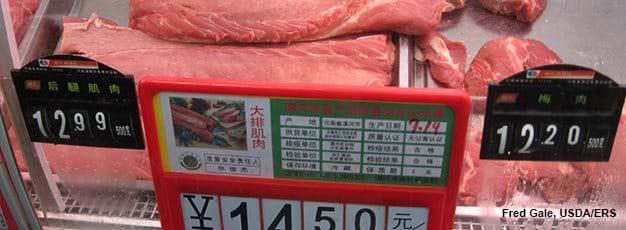China’s Hog Cycle Boosts U.S. Pork Exports

High pork prices in the Chinese market have created opportunities for the U.S. pork industry. However, U.S. pork sales to China have not risen at a steady rate. They tend to rise and fall in rhythm with cyclical changes in China's hog sector.
In recent years, Chinese consumers have been buffeted by large fluctuations in pork prices. Chinese retail pork prices rose more than 50 percent in 2007 over prices in the previous year, and a similar increase occurred in 2011. However, between those years of steep price increases, pork prices fell during 2009-10.
Cyclical price fluctuations result from the biological lag inherent in pork production because it takes a year or more to expand the sow herd and raise a new crop of pigs to market weight. High prices can prompt a buildup of hog inventories that boosts the supply of pork months later. Consequently, pork supplies are sometimes out of sync with current market conditions.
In 2006, for example, depressed pork prices prompted producers to decrease breeding herds and, thus, reduced hog production capacity. Swine disease exacerbated the drop in hog numbers. High pork prices and tight supplies in China led to record U.S. pork sales to China during 2008.
The high pork prices, combined with Chinese Government subsidies, tax incentives, and earmarked loans, attracted an influx of investment into the Chinese hog industry. The resulting expansion in the hog supply sent China's pork prices downward during 2009-10. U.S. pork sales to China fell off sharply as Chinese prices declined. China's H1N1 virus-related ban on U.S. pork shut off most sales for nearly a year beginning in mid-2009.
Depressed hog prices and swine disease in 2010 led to a decline in China's hog inventory that set the stage for another surge in hog prices in 2011. U.S. pork exports to China rebounded strongly during the second half of 2011 after the ban was lifted.
Other factors may limit further expansion of China's pork industry and prove favorable for U.S. sales to China in coming years. Many industry analysts expect that another expansion of production could lead to a decline in Chinese hog prices in 2012 that might once again dampen the growth in U.S. pork exports to China. Growth in pork production in China in 2011 was limited by rising Chinese production costs, disease risk, environmental concerns, land scarcity, and tight credit conditions. A slower expansion of Chinese production and high prices are favorable for continued U.S. pork sales to China.
China's Volatile Pork Industry, by Fred Gale, Daniel Marti, and Dinghuan Hu, USDA, Economic Research Service, February 2012


